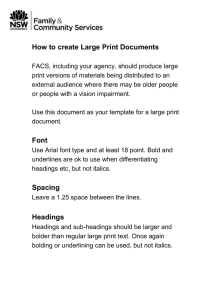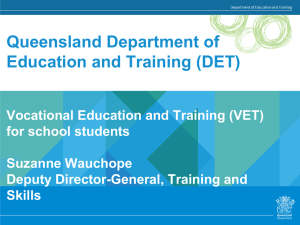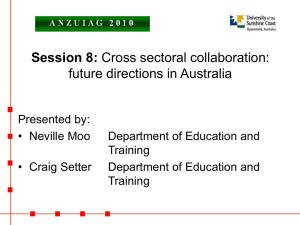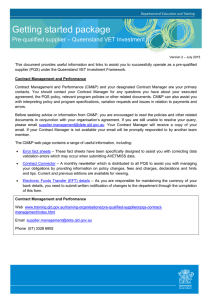Heading 1 Style - Training Queensland
advertisement
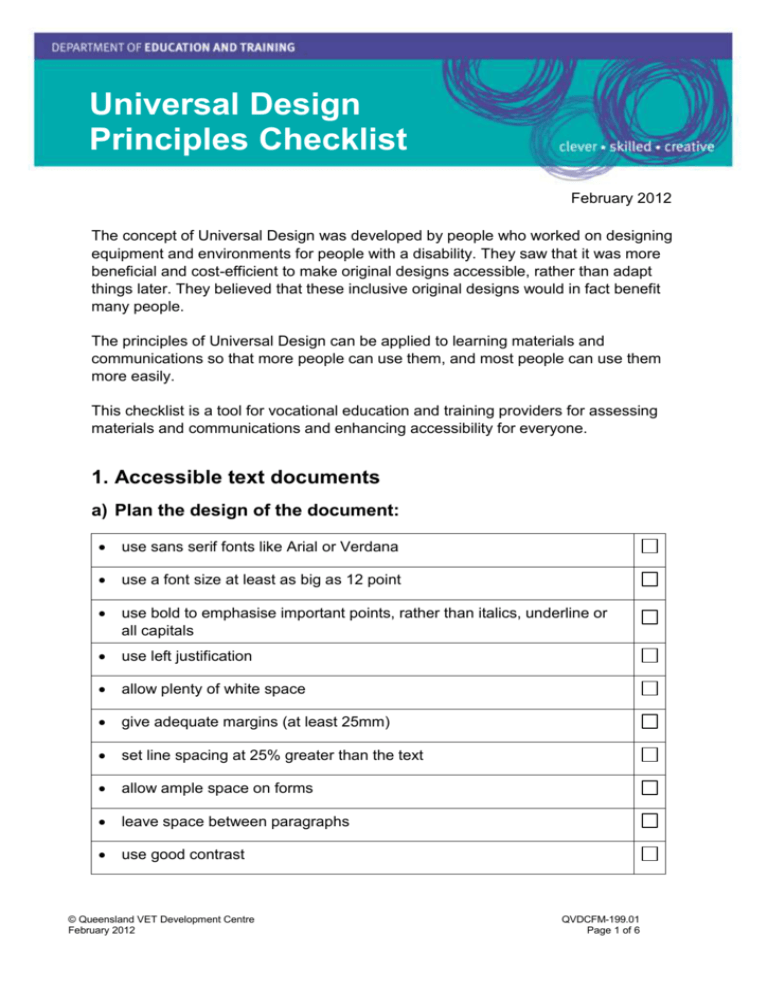
Universal Design Principles Checklist February 2012 The concept of Universal Design was developed by people who worked on designing equipment and environments for people with a disability. They saw that it was more beneficial and cost-efficient to make original designs accessible, rather than adapt things later. They believed that these inclusive original designs would in fact benefit many people. The principles of Universal Design can be applied to learning materials and communications so that more people can use them, and most people can use them more easily. This checklist is a tool for vocational education and training providers for assessing materials and communications and enhancing accessibility for everyone. 1. Accessible text documents a) Plan the design of the document: use sans serif fonts like Arial or Verdana use a font size at least as big as 12 point use bold to emphasise important points, rather than italics, underline or all capitals use left justification allow plenty of white space give adequate margins (at least 25mm) set line spacing at 25% greater than the text allow ample space on forms leave space between paragraphs use good contrast © Queensland VET Development Centre February 2012 QVDCFM-199.01 Page 1 of 6 use headers when creating tables avoid breaking words at the end of a line. For printed documents: avoid shading with poor contrast and glossy paper use light coloured paper. For electronic documents: include alternative text for graphics. b) Write for your reader: identify your audience and the purpose of your document use question and answer format to engage your reader use 'you' and other pronouns to speak directly to your readers use 'I' in headings to pose readers' questions, e.g. ‘How do I appeal an assessment decision?’ use 'we' to refer to your organisation use the active voice use non-discriminatory language. c) Write clearly: use bulleted lists instead of long paragraphs use short sentences use the simplest tense that you can omit superfluous words, e.g. change ‘despite the fact’ to ‘although’ © Queensland VET Development Centre February 2012 QVDCFM-199.01 Page 2 of 6 use 'must' to convey requirements (rather than ‘should’ or ‘shall’) avoid ambiguous placement of words, e.g. ‘If you are determined to be eligible, you can receive ...’ avoid words and constructions that can confuse (e.g. jargon and acronyms) think about how to use contractions, e.g. ‘don't’ instead of ‘do not’ (Contractions soften the tone and make documents easier to read; the two word form is more emphatic and formal) change nominalisations to verbs, e.g. ‘We made an application’ to ‘We applied’ bring abstractions down to earth with examples or diagrams. d) Structure the document clearly: use a table of contents to help make the structure clear use 'styles' (e.g. Microsoft Word headings, body text, bullet lists) format headings by varying size, font and allowing space before and after choose headings carefully and make sure they are informative write short sections include only one issue in each paragraph use vertical lists. © Queensland VET Development Centre February 2012 QVDCFM-199.01 Page 3 of 6 e) Edit your document: enlarge the document to make editing easier a fresh pair of eyes often picks up the ‘obvious’ problems that those who have worked with the document miss if possible, put the draft aside for a while and then come back to it later with a fresh approach. 2. Accessible visual presentations a) Organise the content: keep the content on each screen brief. Use key words and brief, concise phrases. Avoid complete sentences present one idea per visual limit text to six to eight lines per page avoid jargon, acronyms and too many long words use short, simple sentences. b) Take care with colour, contrast, and shading: use high contrast between the text and background and/or visuals avoid printing text over patterned backgrounds. c) Format screens for the best access: use a larger font size (20 – 24 point) so it can be easily read from the back of the room avoid elaborate fonts (sans serif is preferred) avoid italics © Queensland VET Development Centre February 2012 QVDCFM-199.01 Page 4 of 6 minimise the use of capital letters; avoid the use of all capital letters allow adequate line spacing avoid splitting words at the ends of lines. d) Graphics require special consideration: use illustrations that are large enough to be seen clearly. Avoid complex graphs and tables the visual presentation may need to be provided to learners in another format. If graphics convey key information, provide an ‘alternative text' option. e) Presenting visuals: use good transitions between points to keep your audience focused on where you are in the presentation emphasise key points or illustrate themes, but don’t rely heavily on the screen/slide to convey the message read/cover all screen/slide information; never assume everyone can read it be specific when describing diagrams (e.g. tight, left, top, bottom, corner). Avoid terms such as 'over here' or 'over there' try to keep to your presentation if materials have already been distributed. If you vary from the material, mention that fact so those using alternative formats of the materials don't get lost allow enough time to read each visual before talking about it be prepared to provide presentation information in alternative formats, such as large print and audio test visuals on the surface that will be used during the presentation. Sometimes colours and contrasts are fine on a computer screen but are difficult to read when projected. © Queensland VET Development Centre February 2012 QVDCFM-199.01 Page 5 of 6 3. Accessible oral presentations a) Delivering oral presentations: use body language and facial expressions but accompany them with an oral equivalent if any attendee is vision impaired do not substitute body language for words to convey a message speak clearly and at an even pace, using clear intonation and emphasising keywords do not speak too slowly or exaggerate lip movements do not hold the microphone too close to your mouth or hide your mouth with your hands do not breathe heavily into the microphone do not shout be aware that some letters or sounds may be harder to hear or distinguish for people who are hard of hearing (e.g. the letters f and s, and the sound sh) use a range of other communication techniques. This material is adapted from: Regional Disability Liaison Officer research program, Department of Education, Science and Training 2001/2002 A Best Practice Approach to Flexible and Inclusive Teaching: Applying the Universal Design Framework 2003, Australian Flexible Learning Framework, Australian Government Department of Education, Science and Training and state governments. Universal Design – Creating accessible learning resources – Department of Education, Training and the Arts 2007. © Queensland VET Development Centre February 2012 QVDCFM-199.01 Page 6 of 6





